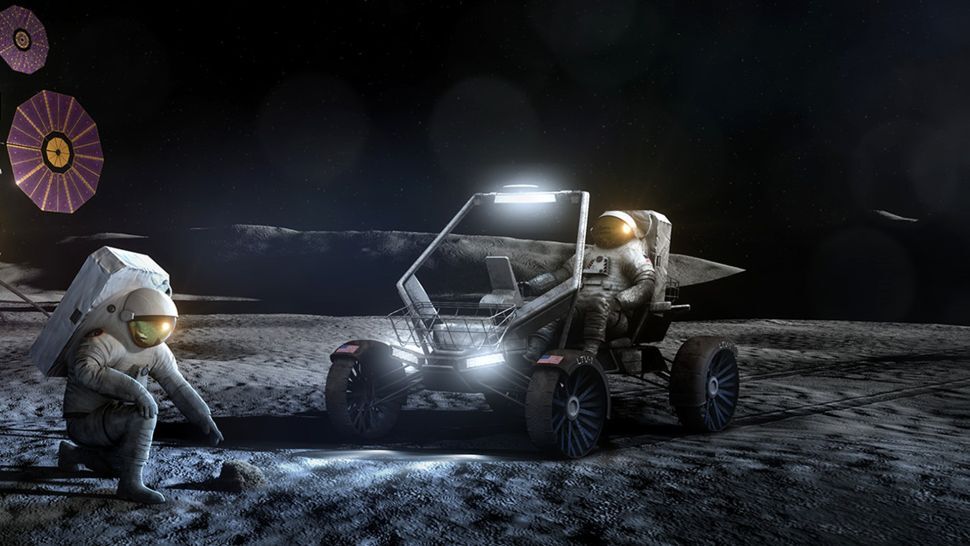10.11.2022
The contracting for the next moon buggy for Artemis has begun.

An astronaut points to a moon rock in front of a proposed next-gen NASA lunar terrain vehicle. (Image credit: NASA)
The search for the next-gen buggy for the upcoming Artemis moon missions has begun.
While the previous lunar vehicles, used during the 1970s Apollo missions, were designed for the relatively balmy climate of the moon's equatorial region (or slightly north of there), NASA's Artemis missions are planned for the lunar south pole, where conditions are expected to be much harsher.
NASA has begun the contracting process(opens in new tab) to have private industry build the next moon rover, officially known as the Lunar Terrain Vehicle (LTV), which Artemis astronauts will use to traverse the area around the moon's south pole and beyond. The new draft request for proposals, which is the first step in the lengthy contracting process, has been published(opens in new tab) for industry partners to review and comment on before providing a formal proposal to build the LTV.
"This draft is one of the first important steps in this exciting project that will allow astronauts to explore farther on the moon than ever before," Lara Kearney, manager of the Extravehicular Activity (EVA) and Human Surface Mobility (HSM) Program at NASA's Johnson Space Center in Houston, said in a NASA statement(opens in new tab). "Gaining industry feedback is crucial as we move forward in issuing a final request for proposal."
The unpressurized rover is expected to traverse hundreds of miles per year to give Artemis astronauts access to a wide variety of locations for prospecting, exploration and scientific research. It will also be capable of remote control if necessary and is expected to be available for commercial uses when not in service of a NASA operation.
In a response to a question about how the new Lunar Terrain Vehicle will be different from the previous vehicle used during the Apollo missions, NASA public affairs officer Rebecca Wickes at Johnson Space Center in Houston told Space.com that "unlike the single-mission-use Apollo Lunar Roving Vehicle (LRV), the Artemis LTV will be developed with modern technology that will allow it to span multiple Artemis missions and perform remotely commanded research in between Artemis crewed missions."
"The new LTV will go farther, last longer, and ultimately accomplish more by orders of magnitude compared to Apollo missions," Wickes continued. "Instead of 'owning' the vehicle, NASA will 'rent' it as a service from industry vendor(s). This strategy will allow NASA to be one of many customers and nurture a healthy space industry for the American economy."
This strategy should ultimately keep the cost to US taxpayers lower than were NASA to contract out the LTV exclusively, as was the case with the lunar roversused during the Apollo missions, which were abandoned on the lunar surface once the missions were completed.
Among the major challenges faced by the Artemis astronauts is working in what are known as permanently shadowed regions of the lunar surface. The moon's axis of rotation is nearly perpendicular to the sun, so there are craters around the lunar south pole that are deep enough that their bottoms haven't seen sunlight in more than 2 billion years.
In addition to these lighting conditions, there is also the issue of keeping an electric vehicle operating in the extreme cold of the lunar south pole. This will be the major challenge for industry hoping to win the new NASA contract for the LTV, which NASA plans to contract out as a service from private contractors rather than owning it outright.
Quelle: SC
